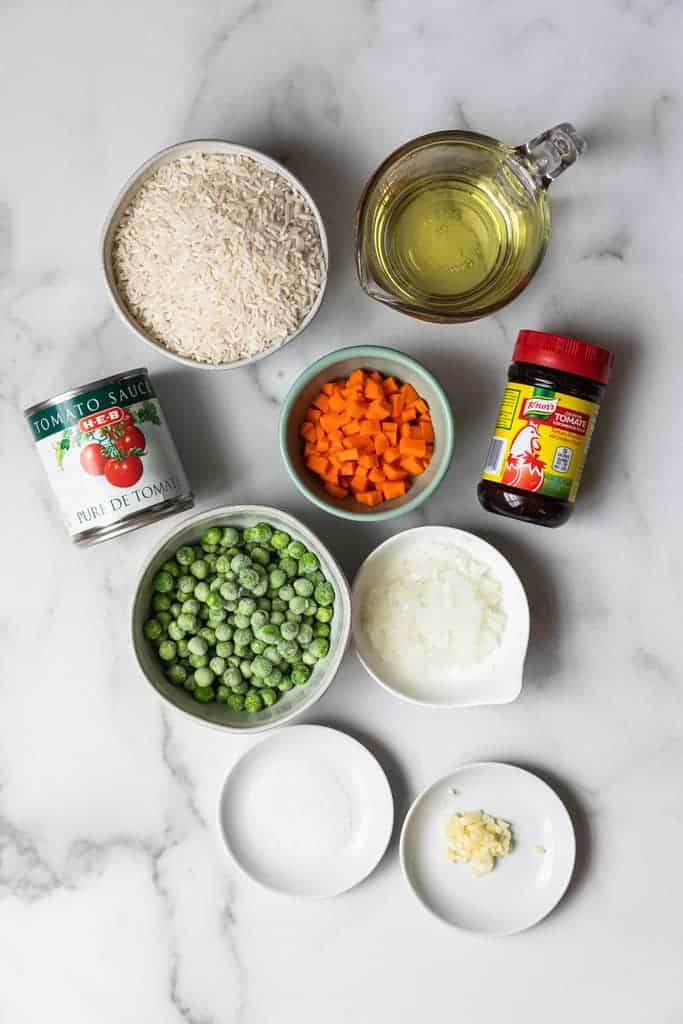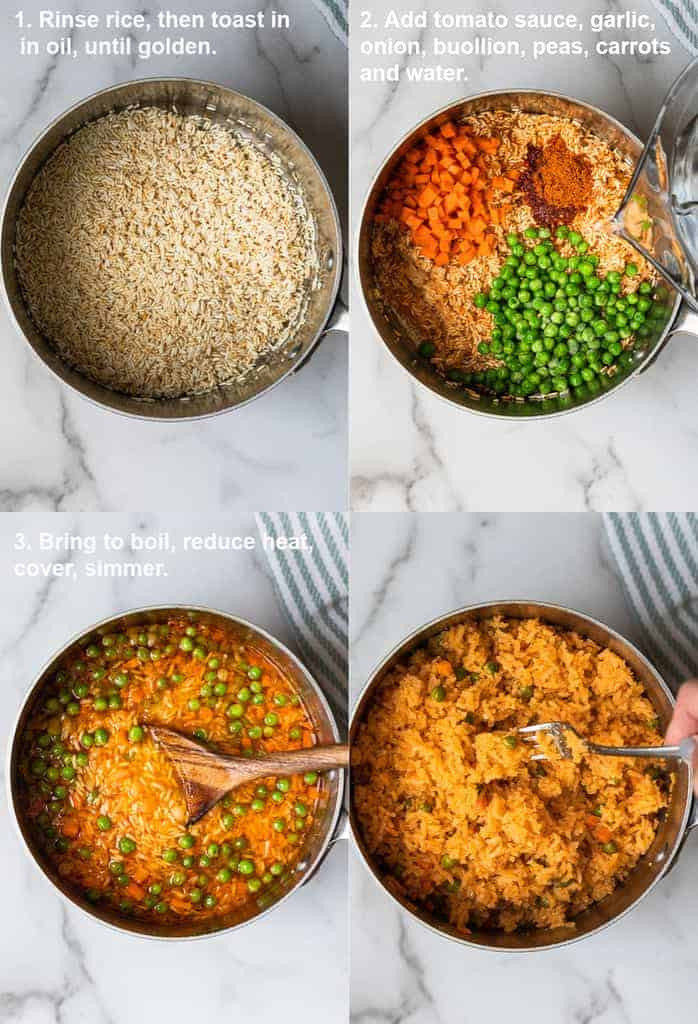Mexican rice, also known as arroz mexicano or Spanish rice, is a staple in Mexican cuisine, and gaymexico.net is here to help you master this classic dish with a vibrant flavor. This guide will provide you with a step-by-step approach on how to make authentic Mexican rice, ensuring a delicious and colorful side dish perfect for any occasion. Get ready to explore the rich culinary traditions of Mexico and impress your friends and family with your newfound skills.
1. What Makes Authentic Mexican Rice Truly Authentic?
Authentic Mexican rice distinguishes itself through its unique flavor profile, vibrant color, and fluffy texture, primarily achieved through specific ingredients and cooking techniques. The use of tomato, onion, garlic, and notably tomato bouillon is key; tomato bouillon imparts that signature reddish-orange hue and a deep, savory flavor. Moreover, toasting the rice before simmering it in liquid is essential for preventing stickiness and ensuring a light, separate grain texture.
1.1 What Ingredients are Essential for Authentic Mexican Rice?
To craft truly authentic Mexican rice, you’ll need:
- Long Grain Rice: The base of the dish, providing a fluffy texture when cooked properly.
- Tomato Sauce or Fresh Tomatoes: These provide the signature color and a tangy base flavor.
- Onion and Garlic: Aromatics that build a savory foundation for the rice.
- Tomato Bouillon: This is the secret ingredient for authentic flavor and color. If you can’t find it, chicken bouillon can be substituted.
- Oil: Used for toasting the rice, which enhances its flavor and texture.
- Water or Chicken Broth: The cooking liquid, with chicken broth offering a richer flavor.
- Optional Vegetables: Carrots, peas, or corn add color, texture, and nutritional value.
1.2 What is the Secret to the Perfect Texture of Mexican Rice?
The texture is paramount when learning how to make Mexican rice. Rinsing the rice thoroughly before cooking removes excess starch, preventing it from becoming gummy. Toasting the rice in oil before adding liquid adds a nutty flavor and helps to keep the grains separate and fluffy. Simmering the rice covered, on low heat, and allowing it to steam undisturbed after cooking are vital steps for achieving the perfect consistency.
1.3 How Does Tomato Bouillon Contribute to Authentic Mexican Rice?
Tomato bouillon, often found in Mexican food aisles, is crucial for achieving the signature flavor and color of authentic Mexican rice. It infuses the rice with a rich, umami flavor that complements the other ingredients. This bouillon also imparts the distinctive reddish-orange hue that makes Mexican rice so visually appealing. According to many Mexican chefs, tomato bouillon is indispensable for the true taste of Mexican rice.
2. How to Prepare Mexican Rice Step-by-Step?
Preparing authentic Mexican rice involves several key steps that, when followed carefully, result in a delicious and satisfying dish. From rinsing and toasting the rice to simmering it perfectly, each step contributes to the final flavor and texture.
2.1 Step 1: Rinsing the Rice
Start by placing 1 ½ cups of long-grain white rice in a fine-mesh strainer. Rinse it under cold running water until the water runs clear. This process removes excess starch, which prevents the rice from becoming sticky and clumpy during cooking. Proper rinsing is essential for achieving the desired fluffy texture.
2.2 Step 2: Toasting the Rice
In a large saucepan or pot, heat ¼ cup of vegetable oil or canola oil over medium-high heat. Add the rinsed rice to the hot oil and stir continuously. Toast the rice for about 5-7 minutes, or until it turns a light golden-brown color. Stirring prevents burning and ensures even toasting, which enhances the nutty flavor and helps the grains stay separate.
2.3 Step 3: Adding Aromatics and Tomato
Add 1 minced garlic clove and ¼ cup of finely diced onion to the saucepan with the toasted rice. Stir and cook for another 1-2 minutes until the onion becomes translucent and fragrant. Next, add ¼ cup of tomato sauce (or 2 pureed fresh tomatoes) to the mixture. Stir well to combine all the ingredients.
2.4 Step 4: Incorporating Bouillon and Seasoning
Stir in 2 teaspoons of tomato bouillon granules (or cubes) and ¼ teaspoon of salt. If you can’t find tomato bouillon, you can substitute it with chicken bouillon for a slightly different flavor profile. Add 3 cups of water (or chicken broth for a richer taste) to the saucepan. Stir to dissolve the bouillon and salt completely.
2.5 Step 5: Simmering to Perfection
Bring the mixture to a boil, then reduce the heat to low. Cover the saucepan tightly with a lid and let the rice simmer for 20 minutes, or until all the water is absorbed and the rice is tender. Avoid lifting the lid during this time, as it can release steam and affect the cooking process.
2.6 Step 6: Resting and Fluffing
Once the rice is cooked, remove the saucepan from the heat and let it rest, covered, for 5-10 minutes. This allows the steam to redistribute, resulting in perfectly fluffy rice. After resting, gently fluff the rice with a fork to separate the grains.
 Toasting the rice for authentic Mexican rice.
Toasting the rice for authentic Mexican rice.
2.7 Step 7: Adding Vegetables (Optional)
If you desire, stir in ½ cup of frozen peas, diced carrots, or corn after fluffing the rice. The heat from the rice will warm the vegetables, adding color, texture, and nutritional value to the dish. You can also add a serrano pepper for extra flavor while cooking, but it won’t make the rice spicy.
3. What are Some Variations of Mexican Rice?
Mexican rice is a versatile dish with several variations, each offering a unique twist on the classic recipe. From incorporating different vegetables and spices to using various cooking methods, there’s a version of Mexican rice to suit every palate.
3.1 How to Make Mexican Green Rice (Arroz Verde)?
Mexican green rice, or arroz verde, distinguishes itself with its vibrant green color and fresh, herbaceous flavor. This variation typically includes blending cilantro, parsley, and sometimes spinach or poblano peppers with water or broth to create a green liquid. This mixture is then used to cook the rice, infusing it with a fresh, vegetal taste. Some recipes also incorporate lime juice for an extra zing.
3.2 Can You Make Mexican Rice in an Instant Pot?
Yes, Mexican rice can be easily made in an Instant Pot, which is an efficient cooking method that yields consistent results. To make Instant Pot Mexican rice, you’ll typically use the same ingredients as the traditional stovetop recipe but adjust the cooking liquid and time. After toasting the rice, add the remaining ingredients, seal the lid, and cook on high pressure for about 5 minutes, followed by a natural pressure release for 10 minutes. This method ensures the rice is perfectly cooked and fluffy.
3.3 What Other Vegetables Can Be Added to Mexican Rice?
While carrots and peas are common additions to Mexican rice, other vegetables can also be incorporated to enhance its flavor and nutritional value. Diced bell peppers, corn kernels, zucchini, and green beans are all excellent choices. These vegetables can be added during the last few minutes of cooking to retain their texture and flavor, or they can be sautéed with the onion and garlic at the beginning for a more integrated taste.
3.4 How to Make Spicy Mexican Rice?
For those who enjoy a bit of heat, making spicy Mexican rice is a great way to add some zest to your meal. This can be achieved by incorporating finely chopped jalapeños or serrano peppers into the rice while it cooks. Alternatively, you can add a pinch of cayenne pepper or a dash of your favorite hot sauce to the cooking liquid. Adjust the amount of spice according to your preference, and be sure to taste as you go to achieve the perfect level of heat.
4. What to Serve with Mexican Rice?
Mexican rice is an incredibly versatile side dish that pairs well with a wide variety of main courses. Its savory flavor and fluffy texture complement both traditional Mexican dishes and other cuisines.
4.1 What are Some Classic Mexican Dishes to Serve with Mexican Rice?
Mexican rice is a staple accompaniment to many classic Mexican dishes. It pairs perfectly with enchiladas, tacos, burritos, and fajitas. It also complements heartier dishes like chili relleno, carne asada, and mole poblano. The rice’s mild flavor and light texture balance the richness and spiciness of these dishes, creating a harmonious meal.
4.2 Can Mexican Rice be Served as a Main Course?
While typically served as a side dish, Mexican rice can also be a satisfying main course, especially when combined with other ingredients. Adding black beans, corn, diced vegetables, and a protein source such as grilled chicken or shrimp can transform it into a complete and nutritious meal. Topping it with avocado, salsa, and a dollop of sour cream or Greek yogurt can further enhance its flavor and appeal.
4.3 What are Some Non-Mexican Dishes that Pair Well with Mexican Rice?
Mexican rice is not limited to Mexican cuisine; it also complements a variety of non-Mexican dishes. It pairs well with grilled or roasted chicken, fish, or pork. It can also be served alongside vegetarian dishes like lentil stews or vegetable curries. The rice’s versatile flavor profile makes it a great addition to any meal, adding a touch of warmth and comfort.
 Mexican Rice with peas and carrots served as a side.
Mexican Rice with peas and carrots served as a side.
4.4 How to Incorporate Mexican Rice into Meal Prep?
Mexican rice is an excellent option for meal prep, as it can be made in large batches and stored for several days. To incorporate it into your meal prep routine, cook a big batch of rice on the weekend and divide it into individual containers. Add your favorite protein and vegetables to create balanced and convenient meals for the week. Mexican rice can be easily reheated in the microwave or on the stovetop, making it a time-saving option for busy individuals.
5. What are Some Common Mistakes to Avoid When Making Mexican Rice?
Making Mexican rice can be straightforward, but certain common mistakes can prevent you from achieving the desired results. Being aware of these pitfalls can help you create perfect, fluffy, and flavorful rice every time.
5.1 Why is My Mexican Rice Mushy?
Mushy Mexican rice is often the result of using too much water or not rinsing the rice properly before cooking. Ensure you use the correct water-to-rice ratio (typically 2 cups of water for every 1 cup of rice) and rinse the rice thoroughly to remove excess starch. Avoiding stirring the rice too much during cooking also helps prevent it from becoming mushy.
5.2 How to Prevent Mexican Rice from Sticking to the Bottom of the Pot?
To prevent Mexican rice from sticking to the bottom of the pot, use a heavy-bottomed saucepan or pot that distributes heat evenly. Toasting the rice in oil before adding the liquid also helps create a barrier that prevents sticking. Ensure the heat is set to low once the rice begins to simmer, and avoid lifting the lid during cooking to maintain consistent temperature and moisture levels.
5.3 What to Do if My Mexican Rice is Undercooked?
If your Mexican rice is still hard or crunchy after the initial cooking time, it likely needs more moisture and time to cook. Add a small amount of water (about ¼ cup) to the pot, cover it tightly, and continue to simmer on low heat for another 5-10 minutes. Check the rice again, and repeat the process if necessary, until it reaches the desired tenderness.
5.4 Can I Use Short Grain Rice Instead of Long Grain Rice?
While long-grain rice is typically recommended for Mexican rice due to its fluffy texture, you can use short-grain rice in a pinch. However, be aware that short-grain rice tends to be stickier, so you may need to adjust the water-to-rice ratio and rinse the rice more thoroughly. Keep a close eye on the rice during cooking to prevent it from becoming too mushy.
6. Health Benefits of Eating Mexican Rice
Mexican rice, when prepared with wholesome ingredients, can offer several health benefits. Understanding these benefits can make this dish an even more appealing addition to your diet.
6.1 What Nutrients Does Mexican Rice Provide?
Mexican rice provides essential nutrients such as carbohydrates, which are a primary source of energy for the body. It also contains small amounts of protein, fiber, and various vitamins and minerals, depending on the ingredients used. Adding vegetables like carrots, peas, and corn can further enhance its nutritional value by providing vitamins A and C, as well as additional fiber.
6.2 How Can I Make Mexican Rice Healthier?
There are several ways to make Mexican rice healthier without sacrificing flavor. Using brown rice instead of white rice increases the fiber content, which aids in digestion and promotes a feeling of fullness. Reducing the amount of oil used and opting for healthier oils like olive oil can decrease the fat content. Incorporating plenty of vegetables and using low-sodium bouillon can also make the dish more nutritious.
6.3 Is Mexican Rice Gluten-Free?
Yes, Mexican rice is naturally gluten-free, making it a suitable option for individuals with gluten sensitivities or celiac disease. However, it’s essential to check the labels of any added ingredients, such as bouillon or tomato sauce, to ensure they are also gluten-free. Preparing the rice from scratch with whole, unprocessed ingredients is the best way to guarantee it remains gluten-free.
6.4 How Does Mexican Rice Fit into a Balanced Diet?
Mexican rice can be a part of a balanced diet when consumed in moderation and prepared with wholesome ingredients. It provides a good source of carbohydrates, which are necessary for energy. Pairing it with lean proteins, vegetables, and healthy fats creates a well-rounded meal that supports overall health. Be mindful of portion sizes and choose healthier preparation methods to maximize its nutritional benefits.
7. The Cultural Significance of Mexican Rice
Mexican rice holds a significant place in Mexican culinary tradition, representing more than just a side dish. Its preparation and consumption are deeply rooted in cultural practices and family traditions.
7.1 What is the History of Mexican Rice?
Rice was introduced to Mexico by the Spanish during the colonial period. Over time, the dish evolved, incorporating local ingredients and flavors to become what is now known as Mexican rice. The recipe was adapted and passed down through generations, becoming a staple in Mexican homes and restaurants. The evolution of Mexican rice reflects the blending of cultures and the ingenuity of Mexican cooks.
7.2 How is Mexican Rice Used in Celebrations and Special Occasions?
Mexican rice is often served during celebrations and special occasions, such as weddings, quinceañeras, and holidays. It is a versatile dish that can be prepared in large quantities to feed a crowd. The vibrant color and comforting flavor of Mexican rice make it a welcome addition to any festive meal, symbolizing abundance and hospitality.
7.3 What Regional Variations of Mexican Rice Exist?
Regional variations of Mexican rice exist throughout Mexico, each reflecting the local ingredients and culinary traditions. For example, in some coastal regions, seafood may be added to the rice, while in other areas, different types of chili peppers or spices may be used to create unique flavor profiles. These regional variations showcase the diversity and richness of Mexican cuisine.
7.4 How Does Mexican Rice Reflect Mexican Identity?
Mexican rice reflects Mexican identity by embodying the country’s culinary heritage and cultural values. The dish represents the blending of indigenous and European influences, as well as the resourcefulness and creativity of Mexican cooks. Its presence in everyday meals and special occasions underscores its importance in Mexican society, symbolizing family, community, and tradition.
8. Expert Tips for Enhancing Your Mexican Rice
To take your Mexican rice to the next level, consider these expert tips that can elevate its flavor, texture, and presentation.
8.1 How to Enhance the Flavor of Mexican Rice?
To enhance the flavor of Mexican rice, experiment with different types of bouillon, such as chicken, vegetable, or shrimp bouillon, to create unique flavor profiles. Adding fresh herbs like cilantro or epazote can also add a burst of freshness. Sautéing the rice with different spices, such as cumin, chili powder, or oregano, can add depth and complexity to the dish.
8.2 What is the Best Way to Store Leftover Mexican Rice?
The best way to store leftover Mexican rice is to let it cool completely before transferring it to an airtight container. Store the rice in the refrigerator for up to 3-4 days. When reheating, add a tablespoon of water or broth to prevent it from drying out. Mexican rice can also be frozen for longer storage; just make sure to thaw it completely before reheating.
8.3 How Can I Reheat Mexican Rice Without Drying it Out?
To reheat Mexican rice without drying it out, add a tablespoon of water or broth to the rice before reheating. Cover the rice with a lid or plastic wrap to trap the moisture. Reheat in the microwave on medium heat, stirring occasionally, until heated through. Alternatively, you can reheat the rice on the stovetop over low heat, stirring frequently and adding more liquid if necessary.
8.4 How to Make Mexican Rice in Advance?
Mexican rice can be made in advance and stored for later use. Cook the rice according to the recipe instructions, then let it cool completely. Transfer the rice to an airtight container and store it in the refrigerator for up to 2 days. When ready to serve, reheat the rice as described above, adding a bit of water or broth to restore its moisture.
9. Addressing Dietary Needs with Mexican Rice
Mexican rice can be easily adapted to meet various dietary needs, making it a versatile dish for a wide range of individuals.
9.1 How to Make Vegan Mexican Rice?
To make vegan Mexican rice, use vegetable broth instead of chicken broth and ensure that the bouillon and tomato sauce are also vegan-friendly. Omit any non-vegan ingredients and add plenty of vegetables to create a nutritious and flavorful dish. Vegan Mexican rice can be a satisfying and delicious option for those following a plant-based diet.
9.2 How to Make Low-Sodium Mexican Rice?
To make low-sodium Mexican rice, use low-sodium broth or water and omit the bouillon or use a low-sodium version. Avoid adding salt to the rice and rely on herbs and spices to enhance the flavor. Fresh tomatoes and vegetables can also add natural flavor without increasing the sodium content.
9.3 How to Make Gluten-Free Mexican Rice?
To make gluten-free Mexican rice, ensure that all ingredients, including the bouillon and tomato sauce, are certified gluten-free. Prepare the rice from scratch using whole, unprocessed ingredients to avoid any potential cross-contamination. Gluten-free Mexican rice can be a safe and delicious option for individuals with celiac disease or gluten sensitivities.
9.4 How to Make Mexican Rice for Diabetics?
To make Mexican rice suitable for diabetics, use brown rice instead of white rice to increase the fiber content and slow down the absorption of sugar. Control portion sizes and pair the rice with lean proteins and plenty of vegetables to create a balanced meal. Avoid adding sugary ingredients and choose low-sodium options to support overall health.
10. Frequently Asked Questions (FAQs) About Making Mexican Rice
Here are some frequently asked questions about making Mexican rice, along with detailed answers to help you master this classic dish.
10.1 Can I use brown rice instead of white rice for Mexican rice?
Yes, you can use brown rice, but you’ll need to adjust the cooking time and liquid ratio. Brown rice typically requires more liquid and a longer cooking time than white rice.
10.2 What is tomato bouillon, and where can I find it?
Tomato bouillon is a granulated or cubed seasoning made from dried tomatoes, spices, and flavor enhancers. It adds a distinct tomato flavor and reddish-orange color to Mexican rice. You can typically find it in the Mexican food aisle of most grocery stores or online.
10.3 How do I prevent my Mexican rice from being too sticky?
To prevent sticky Mexican rice, rinse the rice thoroughly before cooking to remove excess starch. Toasting the rice in oil before adding the liquid also helps to keep the grains separate. Avoid stirring the rice too much during cooking and allow it to rest, covered, after cooking to allow the steam to redistribute.
10.4 Can I add other vegetables besides carrots and peas?
Yes, you can add a variety of other vegetables to Mexican rice, such as corn, bell peppers, zucchini, or green beans. Add the vegetables during the last few minutes of cooking to retain their texture and flavor.
10.5 What is the ideal water-to-rice ratio for Mexican rice?
The ideal water-to-rice ratio for Mexican rice is typically 2 cups of water for every 1 cup of rice. However, you may need to adjust this ratio depending on the type of rice you use and your personal preferences.
10.6 How long can I store leftover Mexican rice in the refrigerator?
You can store leftover Mexican rice in the refrigerator for up to 3-4 days. Make sure to store it in an airtight container and let it cool completely before refrigerating.
10.7 Can I freeze Mexican rice for longer storage?
Yes, you can freeze Mexican rice for longer storage. Let it cool completely before transferring it to an airtight container or freezer bag. Frozen Mexican rice can be stored for up to 2-3 months.
10.8 How do I reheat frozen Mexican rice?
To reheat frozen Mexican rice, thaw it completely in the refrigerator before reheating. Add a tablespoon of water or broth to the rice before reheating to prevent it from drying out. Reheat in the microwave or on the stovetop until heated through.
10.9 Is Mexican rice suitable for people with dietary restrictions?
Yes, Mexican rice can be easily adapted to meet various dietary needs, such as vegan, gluten-free, low-sodium, and diabetic-friendly. Use appropriate ingredients and preparation methods to accommodate specific dietary restrictions.
10.10 Can I use chicken broth instead of water for Mexican rice?
Yes, you can use chicken broth instead of water for Mexican rice to add a richer and more savory flavor. Use low-sodium chicken broth to control the sodium content of the dish.
Mastering how to make Mexican rice opens a gateway to enjoying a staple dish that’s both versatile and deeply rooted in culture. From choosing the right ingredients and avoiding common mistakes to adapting the recipe for dietary needs and exploring regional variations, this guide provides all the information you need to create perfect Mexican rice every time. Whether you’re serving it as a side dish or incorporating it into a main course, Mexican rice is sure to be a crowd-pleaser. For more information on Mexican cuisine and culture, be sure to visit gaymexico.net.
Are you ready to explore more of Mexico’s culinary delights and LGBTQ+ friendly destinations? Visit gaymexico.net today for travel guides, event listings, and community connections. Discover the best of Mexico with confidence and pride! Address: 3255 Wilshire Blvd, Los Angeles, CA 90010, United States. Phone: +1 (213) 380-2177. Website: gaymexico.net.

